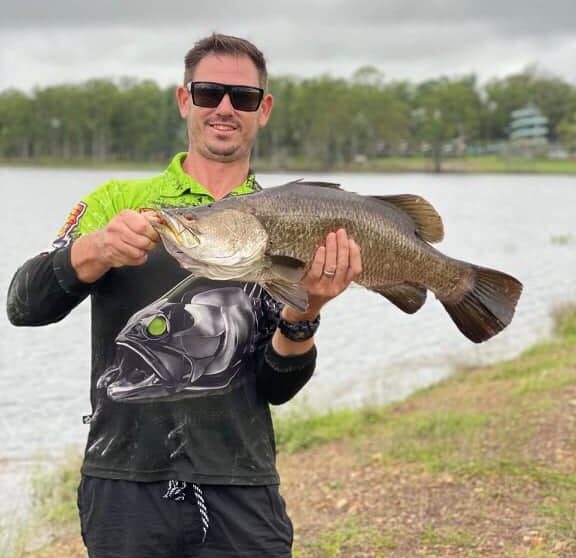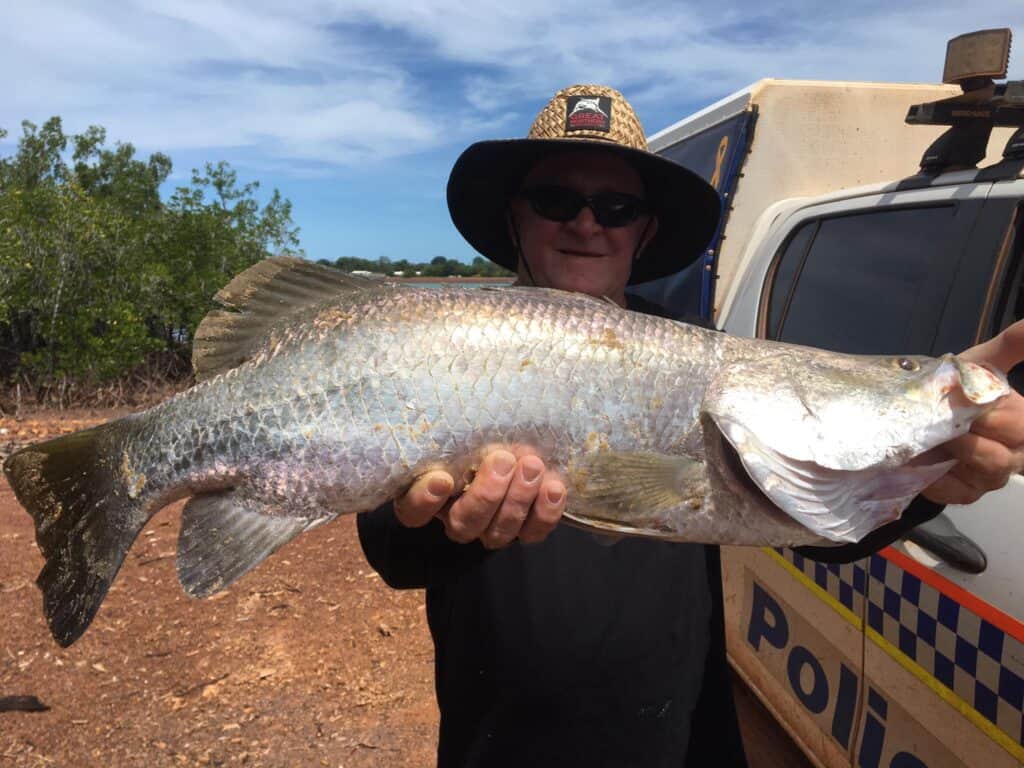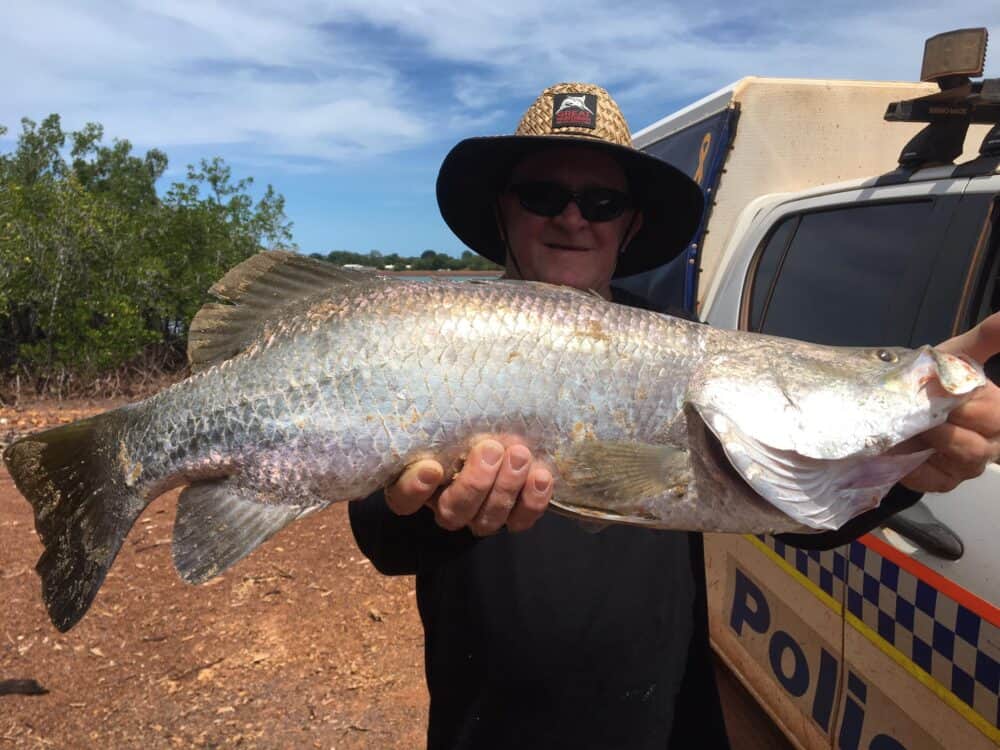With the winter months upon us, many anglers’ thoughts turn to warmer weather and fishing for pelagic species such as mackerel and tuna. But what about those who love to target Australia’s iconic barramundi? Can you still catch them in the winter months or is it time to hang up the rods until spring arrives?
You can catch barramundi all year round in Australia, but the winter months can be tough. The water temperature drops, and the fish become less active, making them harder to catch. Barramundi eat less during winter, so they’re not as interested in baits and lures as they are in other seasons.
That doesn’t mean you can’t catch barramundi in winter, though. If you know where to find them and what techniques to use, you can still have a lot of success. Read on as we explore the best ways to catch barramundi in Australia during winter.

Where To Find Barramundi In Winter
In winter, barramundi tends to congregate in deeper, slower-moving waters. This could be a deep hole in a river, creek, or billabong off the main channel. Look for areas with plenty of structure, such as:
tends to congregate in deeper, slower-moving waters. This could be a deep hole in a river, creek, or billabong off the main channel. Look for areas with plenty of structure, such as:
- Logs.
- Rocks.
- Boulders.
The barramundi will use these areas to shelter from cold water and currents.
They’ll also often be found around the mouths of rivers and creeks, where the water is a bit warmer. As the sun rises, barramundi will move into shallower waters to feed.
You’ll find them hanging around in areas with a plentiful food supply. This could be a deep pool with lots of baitfish or a channel with plenty of prawns and yabbies.
Since their metabolism rates slow down durin g winter, barramundi doesn’t need to eat as much. So, they’re not as active and won’t be chasing lures and baits as aggressively as in other seasons.
g winter, barramundi doesn’t need to eat as much. So, they’re not as active and won’t be chasing lures and baits as aggressively as in other seasons.
This means you’ll need to slow down your presentation and use techniques that entice them to bite. Remember, barramundi are opportunistic feeders. So even though they’re not actively chasing baitfish, they’ll still strike if something comes close enough.
Techniques For Catching Barramundi In Winter
Due to the cold water temperatures, barramundi are less active in the winter. Unlike during warmer months, when they chase baitfish for long distances, in winter, they will often just sit and wait for their prey to come to them.
The key to catching barra in winter is to use techniques that entice them to bite, even when they’re not feeling very aggressive. These include:
Live Baiting For Barramundi
Live baiting is one of the most effective ways to catch barramundi in winter. The scent and movement of a live bait fish are often enough to trigger a strike, even when the fish feels sluggish.
Live bait fish such as herring, mullet, and gar are great options. Freshly caught prawns are also an excellent choice.
If you’re live baiting, using the right rig is essential. A paternoster rig with two hooks is a good option, as it will allow the baitfish to swim freely and entice the barramundi to bite. Ensure you use a strong leader, as barramundi are powerful fish and can easily break lighter lines.
Cast your live bait out and allow it to swim around in the water. You may need to give it a little help by gently reeling in and then letting the bait fish swim back out again. The goal is to keep the baitfish alive and swimming for as long as possible so that it’s more tempting to the barramundi.
Slow Trolling Lures For Barramundi
While barramundi are less active in winter, they will still strike at lures if they’re presented in the right way. Slow trolling lures are an excellent technique for catching barra in winter.
The slow, deliberate presentation of the lure is enough to trigger their predatory instinct, even when they’re not feeling very aggressive. Slow-trolling a soft plastic along the bottom is a good technique to use in deep water while working it through weed beds and other structures in shallow water.
When choosing a lure, look for something that imitates a bait fish or prawn. Vibration lures are also a good option, as they can effectively attract the attention of barramundi. You will need to experiment with different lures and retrieve speeds to find what works best.
Barramundi Jigging In Deep Water
Jigging is another great technique for catching barramundi in winter. It’s particularly effective in deep water, where the fish often hold close to the bottom. Jigs are designed to resemble baitfish, prawns, or other creatures that barramundi like to eat.
They are usually made from metal or plastic and have a weighted head, which helps them sink quickly to the bottom. Jigging involves vertically retrieving the lure so that it rises and falls through the water column. As it does, the jig will often impart a wobbling or fluttering action, which can be irresistible to barramundi.
You will need to experiment with different jigging techniques to find what works best. Often, a slow, steady retrieve is enough to trigger a strike. But in some cases, you may need to use a faster, more erratic retrieve to get the fish’s attention.

Tips For Catching Barramundi In Winter
Catching barramundi in winter requires a little patience and experimentation. But with the proper techniques, you can still have success. Here are a few tips to help you catch barramundi in winter:
- Look for areas where baitfish are congregating. Barramundi often sits and wait for baitfish to come to them in winter, so it’s important to fish where the baitfish are. This could be around weed beds, drop-offs, or other sheltered structures.
- Use live bait whenever possible. The scent and movement of a live bait fish are often enough to trigger a strike, even when the fish are feeling sluggish.
- Slow down your presentation. In winter, barramundi is less active and more inclined to sit and wait for their prey. So, it’s important to slow down your lure presentation and give the fish time to strike.
- Use vibration lures. Vibration lures can effectively attract barramundi’s attention, even when they’re not feeling very aggressive.
Final Thoughts
While barramundi is more active during the warmer months and bites more readily, there are still plenty of ways to catch them in winter. You can increase your chances of success by targeting areas where baitfish are congregating and using live bait whenever possible.
And by slowing down your presentation and using vibration lures, you can trigger strikes even when the fish feel sluggish. So don’t be discouraged if you don’t get a bite right away. With a little patience and experimentation, you can still catch barramundi in winter.
More Pages On Fishing
The Underestimated Threat: Stonefish In Hervey Bay Ecosystems
Stonefish are known to inhabit various coastal regions around the world, and Hervey Bay in Australia has had a few encounters over the years with the dreaded stonefish. Hervey Bay offers a...
There are two broad types of Australian Salmon – Eastern Australian Salmon and Western Australian Salmon. Both are marine fish often found along the southern coast of Australia, and both are...


